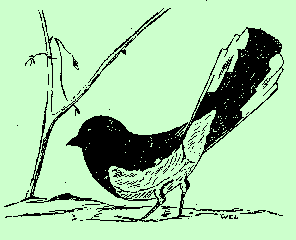|







|
. |
The Rufous-Sided Towhee
(Spotted Towhee -- Arctic Towhee -- Oregon Towhee)


 In the western canyons in the spring or summer, one of the larger birds
likely to be seen is the Towhee (Pipilo erythrophthalmus), which is
smaller and more slender than the robin. The head and upper parts are black,
as are the wings and tail, but marked with much white lika a gauzy mantle
of silver thrown over the shoulders, which shows plainly in flight. Note the
rufous sides, white under parts, and red iris. The female is similar, but
dusky brown where the male is black. The young in summer are streaked below
like slender sparrows, but have the tail pattern of this towhee.
In the western canyons in the spring or summer, one of the larger birds
likely to be seen is the Towhee (Pipilo erythrophthalmus), which is
smaller and more slender than the robin. The head and upper parts are black,
as are the wings and tail, but marked with much white lika a gauzy mantle
of silver thrown over the shoulders, which shows plainly in flight. Note the
rufous sides, white under parts, and red iris. The female is similar, but
dusky brown where the male is black. The young in summer are streaked below
like slender sparrows, but have the tail pattern of this towhee.

 The towhee mews almost as perfectly as the catbird, and is often mistakenly
called the catbird on that account. It sings a sweet and levely melody, and
has also a "chip" note as it flits from bush to bush. In the spring his
song is often loud and beautiful. Dr. J. H. Paul comments, "The towhee's
song is sprightly, cheerful, wild and free, with all the swing of the
out-of-doors, and not pitched to a minor key. During the nesting season, the
male sings for many minutes at a time from the top of some favorite tree or
tall bush; but in the vicinity of the nest he is silent. A bird that sings
so blithesome a song must surely be happy; and so he is, with that pretty
mate whom he courts and cares for. Moreover, the towhee is friendly, and
seems to enjoy your watching him. He flits in and out of the bushes, mewing,
chipping and moving his long tail so gracefully that you soon admire this
interesting creature. Towhees are among our prettiest, liveliest and most
sociable birds."
The towhee mews almost as perfectly as the catbird, and is often mistakenly
called the catbird on that account. It sings a sweet and levely melody, and
has also a "chip" note as it flits from bush to bush. In the spring his
song is often loud and beautiful. Dr. J. H. Paul comments, "The towhee's
song is sprightly, cheerful, wild and free, with all the swing of the
out-of-doors, and not pitched to a minor key. During the nesting season, the
male sings for many minutes at a time from the top of some favorite tree or
tall bush; but in the vicinity of the nest he is silent. A bird that sings
so blithesome a song must surely be happy; and so he is, with that pretty
mate whom he courts and cares for. Moreover, the towhee is friendly, and
seems to enjoy your watching him. He flits in and out of the bushes, mewing,
chipping and moving his long tail so gracefully that you soon admire this
interesting creature. Towhees are among our prettiest, liveliest and most
sociable birds."

 The towhee's nest is usually placed on the ground, but sometimes may be
found in shrubs and low bushes near the ground. It is usually made of a
collection of dead leaves, strips of grapevine or other bark, a few twigs,
and is lined with fine, dried grasses. Ample in size, it is rather frailly
built and usually disintegrates during the autumn rains and winter storms.
The white eggs (3 to 6), finely and evenly spotted with dark red, are laid
usually in May. The male may help incubate the eggs.
The towhee's nest is usually placed on the ground, but sometimes may be
found in shrubs and low bushes near the ground. It is usually made of a
collection of dead leaves, strips of grapevine or other bark, a few twigs,
and is lined with fine, dried grasses. Ample in size, it is rather frailly
built and usually disintegrates during the autumn rains and winter storms.
The white eggs (3 to 6), finely and evenly spotted with dark red, are laid
usually in May. The male may help incubate the eggs.

 "The towhee has one unfortunate weakness", writes T. Gilbert Pearson. "It
allows itself to be imposed upon by the cowbird. The happiness of many a
towhee home is ruined by this dark destroyer of wild bird life. The cowbird,
which makes no nest of its own, often lays one or more of its eggs in the
towhee's nest, where they are allowed to remain and hatch. The young cowbird
grows rapidly, and often crowds some of the young towhees from the nest."
"The towhee has one unfortunate weakness", writes T. Gilbert Pearson. "It
allows itself to be imposed upon by the cowbird. The happiness of many a
towhee home is ruined by this dark destroyer of wild bird life. The cowbird,
which makes no nest of its own, often lays one or more of its eggs in the
towhee's nest, where they are allowed to remain and hatch. The young cowbird
grows rapidly, and often crowds some of the young towhees from the nest."

 John James Audubon, the great naturalist and artist, who was such a close
observer of birds, in writing of the towhee said, "The young leave the nest
long before they are able to fly, and follow the mother about on the ground
for several days. Some of the nests of this species are so well concealed
that in order to discover them, one requires to stand quietly on the first
appearance of the mother. They generally rest on the ground at night, when
many are caught by weasels and other small quadrupeds."
John James Audubon, the great naturalist and artist, who was such a close
observer of birds, in writing of the towhee said, "The young leave the nest
long before they are able to fly, and follow the mother about on the ground
for several days. Some of the nests of this species are so well concealed
that in order to discover them, one requires to stand quietly on the first
appearance of the mother. They generally rest on the ground at night, when
many are caught by weasels and other small quadrupeds."

 The towhees are nearly omnivouous. Edward Forbush, who has spent a great
deal of time finding out just what birds eat, tells us that towhees are fond
of ants and a great variety of beetles. Hairy caterpillars are eaten in
great numbers, and in gardens or fields under cultivation, towhees flit
along the bround in search of cabbage worms and pill bugs, which are
destructive to crops. They also eat grasshoppers, cockroaches, flies, and
are fond of the juicy earthworms. It is this sort of food that the towhees
search for so diligently on the ground in a thicket, where we may hear them
scratching among the fallen leaves and throwing them about with an energy
and vigor surprising in a bird that measures only about 8 1/2 inches in
length. The towhee is a very useful bird to mankind, and should receive the
most careful protection by everyone.
The towhees are nearly omnivouous. Edward Forbush, who has spent a great
deal of time finding out just what birds eat, tells us that towhees are fond
of ants and a great variety of beetles. Hairy caterpillars are eaten in
great numbers, and in gardens or fields under cultivation, towhees flit
along the bround in search of cabbage worms and pill bugs, which are
destructive to crops. They also eat grasshoppers, cockroaches, flies, and
are fond of the juicy earthworms. It is this sort of food that the towhees
search for so diligently on the ground in a thicket, where we may hear them
scratching among the fallen leaves and throwing them about with an energy
and vigor surprising in a bird that measures only about 8 1/2 inches in
length. The towhee is a very useful bird to mankind, and should receive the
most careful protection by everyone.

 Mr. Harry Aldous writes, "I watched a pair of towhees through field glasses,
and saw them make over fifty trips to the nest in two hours -- each time
with either a small gray moth of a green caterpillar, which they found by
scratching among the dead leaves on the ground."
Mr. Harry Aldous writes, "I watched a pair of towhees through field glasses,
and saw them make over fifty trips to the nest in two hours -- each time
with either a small gray moth of a green caterpillar, which they found by
scratching among the dead leaves on the ground."

 The towhee's habitat is brush, chaparral, undergrowth, forest edges and city
shrubs. In the West, it breeds from southern Canada to southwest California,
south Arizona, New Mexico and west Texas. It winters mainly from south
British Columbia, Utah, Colorado and southward.
The towhee's habitat is brush, chaparral, undergrowth, forest edges and city
shrubs. In the West, it breeds from southern Canada to southwest California,
south Arizona, New Mexico and west Texas. It winters mainly from south
British Columbia, Utah, Colorado and southward.

 The writer has enjoyed the privilege of watching and studying four of these
beautiful birds in our own back yard for the past several months.
The writer has enjoyed the privilege of watching and studying four of these
beautiful birds in our own back yard for the past several months.
-- by Marie Allred Atkinson
|
|

